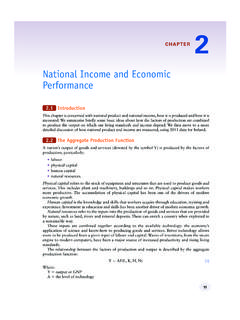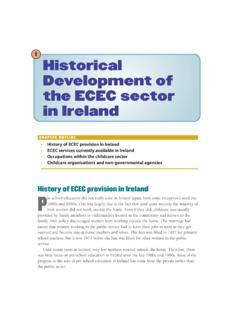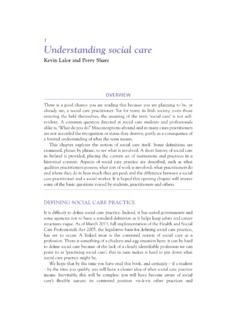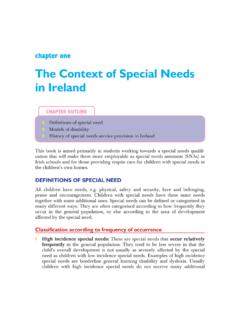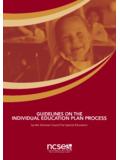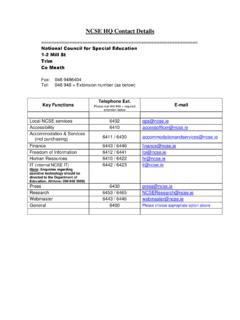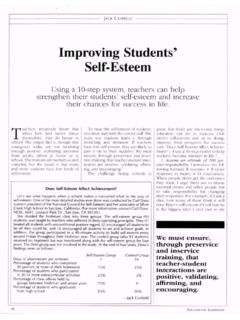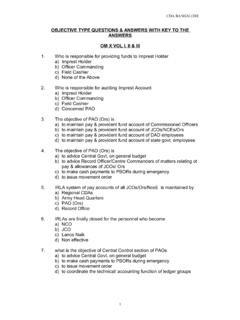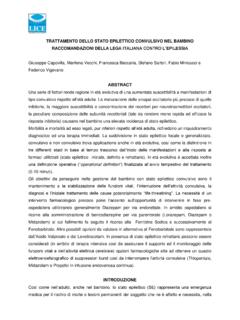Transcription of Educational Needs 2nd EDITION:Special Educational Needs
1 Educational Needs 2nd EDITION:Special Educational Needs 11/07/2011 09:29 Page vii Contents Acknowledgments viii Chapter 1: Identifying the Issues 1. Section 1: Setting the Scene 9. Chapter 2: The Experiences of People with Disabilities: Marginalisation, Recognition and Rights 11. Chapter 3: Historical Emergence: The Irish Experience 29. Chapter 4: Developing Policy and Provision in Special Education 47. Chapter 5: Moving towards Schools for All 73. Section 2: Beginning the Process 93. Chapter 6: Addressing Core Issues in Special Education 95. Chapter 7: Identification and Assessment of Special Educational Needs 119. Chapter 8: Individual Education Planning 138.
2 Section 3: Developing Classroom Strategies 153. Chapter 9: Accessing the Curriculum: Models of Differentiation 155. Chapter 10: Examining Difficulties in Literacy and Numeracy 172. Chapter 11: Understanding and Approaching Behaviour Difficulties 195. Chapter 12: Strategies for Specific Special Educational Needs 215. Section 4: Sustaining Collaborative Approaches 237. Chapter 13: Developing Collaborative Relationships with Parents and Families 239. Chapter 14: Creating and Developing Partnerships within Schools 255. Chapter 15: Conclusion: Mapping the Road Ahead 267. References 271. Glossary 291. Index 296. Educational Needs 2nd EDITION:Special Educational Needs 11/07/2011 09:29 Page 47.
3 Chapter 4. Developing Policy and Provision in Special Education Learning outcomes/objectives On completion of this chapter, the reader will be able to: Identify and critically examine the policy shifts in the health sector towards people with disabilities in Ireland in the 1980s. Analyse the policy progression as outlined in the key reports, judicial decisions and legislative developments in Ireland from the SERC Report (1993) to the Sinnott judgment of 2000. Evaluate the impact of the Education Act 1998 and the Education for Persons with Disability Act (EPSEN) 2004 on special education policy and provision. Critically consider the systemic resourcing and restructuring of special education services in Ireland and the establishment of the National Council for Special Education (NCSE).
4 Introduction In this chapter we will examine the radical shift in special education policy that occurred throughout the 1990s and into the present century. As Hill (2005: 4). observed, the policy process is essentially a complex and multi-layered one.'. Special education policy evolved rapidly from a primary focus on Educational provision for distinct categories of disabled children towards a more inclusive view of special education principally delivered within mainstream settings. This significant policy evolution occurred through the interplay of a variety of factors at national and international levels. Internationally, the rights-based principles underlying policy statements from the United Nations, European Community, UNESCO and the OECD had resulted in a fundamental re-examination of Educational provision for children with special Educational Needs .
5 There was an increasing recognition that these children and their peers without special Educational Needs would benefit from being educated together and learning to live together. Nationally, the last decade of the twentieth century witnessed the unfolding of major Educational initiatives that shaped the organisation and delivery of Educational provision. This involved significant changes in system administration, school management and curriculum. Special Educational provision was documented and critiqued through government-sponsored reports that resulted in major changes in policy and provision. Parental litigation Educational Needs 2nd EDITION:Special Educational Needs 11/07/2011 09:29 Page 48.
6 48 Responding to Special Educational Needs challenging inadequate Educational provision for their children who had special Educational Needs also had a significant impact in promoting change in special education policy and practice. Developments in social policy with regard to disability issues and the rights of children also accelerated changes in perspectives on special Educational provision. Internationally, policy development in special education and health-related service delivery for people with disabilities has been profoundly influenced by supra-national bodies such as the United Nations. The United Nations Declaration on the Rights of Disabled Persons (1975), for example, and the subsequent UN-sponsored International Year of the Disabled in 1981 signalled the beginning of a public policy debate around the rights of people with disabilities to equitable access to and participation in mainstream societal activities.
7 Within the European Community, funding programmes for training and employment schemes have been based on the principle of ensuring equitable access for all disadvantaged minorities, including those with disabilities. National policy: Initiatives in the health sector Within Ireland, public policy in relation to people with disabilities remained relatively unchanged until the 1980s. Until then, the Department of Health was principally responsible for the medical treatment, care, education, training and even the employment of people with disabilities. There was a gradual realisation, informed by international developments, that the marginalised position within society of people with disabilities required urgent action on many fronts.
8 Doyle (2003: 26) observed: In the last decade, public policy has tried to address the twin issues of equality and universal access through anti- discrimination legislation, with right of redress, coupled with a mainstream approach to service delivery.' As will be evident in the discussion below, Ireland has attempted to follow this path through enacting enabling legislation and the gradual mainstreaming of provision in both education and health services. In consultation with organisations representing disabled people, the Department of Health developed a number of significant policy initiatives that influenced the direction of Educational provision for people with disabilities.
9 These included the Green Paper on Services for Disabled People (1984) and Needs and Abilities: A Policy for the Intellectually Disabled (1991). The Green Paper opened with a government commitment to developing services and facilities which will enable disabled people to achieve full participation and equality in our society' (p. 9). It goes on to state that the Department of Education has been intensifying efforts to enable disabled children to receive their education in the least restrictive environment' (p. 45). The Green Paper recounted the recognition of the increasing demands for integrated education for children with disabilities alongside their peers in their local community, as outlined in the White Paper on Educational Development (1980).
10 Various recommendations for increased resources in relation to psychological and care Needs in particular were Educational Needs 2nd EDITION:Special Educational Needs 11/07/2011 09:29 Page 49. Developing Policy and Provision in Special Education 49. advanced in the Green Paper, though there did not appear to be a coherent vision of what integrated education would actually involve. It is evident that despite the reference to education in the least restrictive environment, parallel systems of special and general education would remain for the foreseeable future. There appeared to be resistance to safeguarding the rights of disabled people to equitable services through legislation as enacted in other countries.

